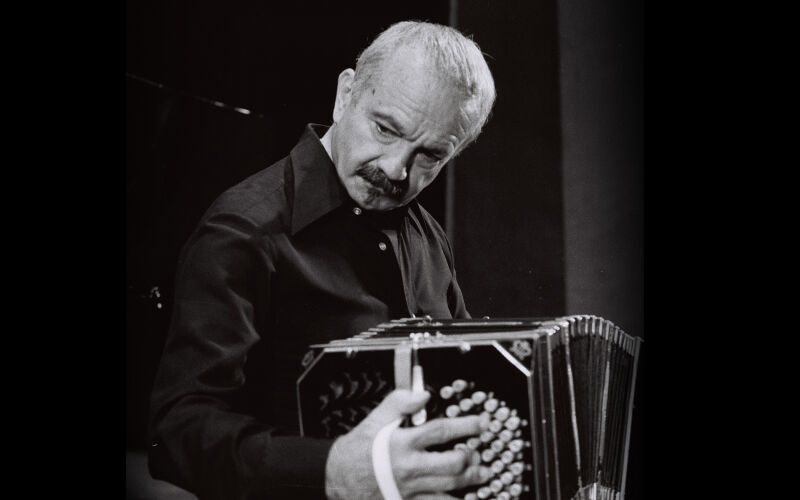Borges Music – Astor Piazzolla
- At September 02, 2019
- By Great Quail
- In Borges
 0
0
Well, Guastavino asked me if I could write a milonga and I told him: “I don’t know, I’ve never written any.” And then I remembered the name of Jacinto Chiclana, and a vague story that he was killed fighting against many. And then, without meaning to—I was walking, yes, on Peru Street—without meaning to, suddenly, I felt that something was going to happen, and that something was this milonga. And the rest all came out, as I tell you, from my blood.
—Jorge Luis Borges in conversation with Antonio Carrizo
Astor Piazzolla
(1921-1992)
Introduction
One of the founders of nuevo tango, Astor Piazzolla helped reinvigorate Argentina’s traditional art form by blending it with classical and jazz. Piazzolla’s music is complex yet emotionally direct, a playful mixing of genres from his “tango operas” to his jazz-influenced work with El Conjunto Electrónico. Like his fellow Argentine Borges, who collaborated with Piazzolla in the sixties, Piazzolla frequently casts Buenos Aires in a mythical light.
Biography
Astor Pantaleón Piazzolla was born in 1921 in Mar la Plata, an Argentine fishing port destined to become a beach resort. His father and mother, Vicente “Nonino” Piazzolla and Assunta Manetti, were both second-generation Italian immigrants. In 1925, Vicente moved the Piazzolla family to New York City.
After his father gave him a bandoneón—a German concertina made popular by Argentine tango musicians—the young Piazzolla began playing along with his father’s tango records. Growing up in Greenwich Village and Little Italy, he was also influenced by jazz and classical music, and began incorporating both into his own musical compositions. In 1936 his family returned to Argentina, and soon Piazzolla was making a name for himself as a virtuoso bandoneonista, eventually joining the famous tango band of Aníbal “Pichuco” Troilo.
As Piazzolla deepened his study of modern music, his avant-garde inclinations clashed with his traditionally-minded partners. In 1946 Astor Piazzolla formed his own band, the ironically-named Orquesta Típica—the term for traditional bands that played popular tangos. Eventually Piazzolla’s increasing passion for Bartók and Stravinsky lured him away from tango. In 1954, Piazzolla was granted a scholarship to study classical music under the legendary Nadia Boulanger in Paris. There, Piazzolla realized that his destiny was not to abandon tango, but to infuse it with elements drawn from classical and jazz, particularly dissonance, harmony, and counterpoint.
Piazzolla returned to Buenos Aires and formed two new groups, the song-based Orquesta de Cuerdas, or “String Orchestra,” and the more avant-garde Octeto Buenos Aires. These helped Piazzolla launch a movement called “nuevo tango,” or “new tango.” Like the “nuevo flamenco” that would soon shake up traditional music in Spain, nuevo tango was controversial, earning as many detractors as admirers and sharply dividing the generations.
During the next two decades, Piazzolla alternated his time between Buenos Aires, New York, and Paris, organizing several musical groups and refining his voice as a composer. He waited out the second Perón regime and subsequent junta in Italy, his reputation growing as he organized numerous international concerts and events. By the time the political situation had stabilized in Argentina, Astor Piazzolla had become globally famous, his music embraced by classical and jazz enthusiasts alike. The traditional world of tango soon followed, and by the end of the 1980s, Astor Piazzolla had become Argentina’s most celebrated musician.
In 1990, Astor Piazzolla fell into a coma, remaining unconscious until his death on 4 July 1992.
In the years since his death, Piazzolla’s fame has only increased, and productions of his works are performed regularly around the world. In 2008 the Aeropuerto Internacional Brigadier General Bartolomé de la Colina in Mar la Plata was renamed the Aeropuerto Internacional de Mar del Plata Ástor Piazzolla, or the “Astor Piazzolla International Airport.”
Borges-Related Works
Each of Astor Piazzolla’s Borges-related works has its own page with information, reviews, liner notes, and music samples.
El tango (1965)
Piazzolla set some of Borges’ poems and milongas to music on the album El tango.
María de Buenos Aires (1968)
Piazzolla’s great tango operita, this surreal work was a collaboration with poet Horacio Ferrer. Although not directly related to Borges, its themes are often reminiscent of Borges’ early work.
A intrusa (1979)
Piazzolla’s score to A intrusa, a homoerotic Brazilian movie directed by Carlos Hugo Christensen and loosely based on Borges’ story “The Intruder.”
The Rough Dancer and the Cyclical Night (1987)
A cycle of fourteen pieces inspired by Borges’ poetry, this work was commissioned for the Hispanic American Arts Center’s production of Tango Apasionado.
Borges & Piazzolla (1997)
A modern remake of El tango, this exuberant album brings Borges’ mythical Buenos Aires to life through music, song, and narration.
 Additional Information
Additional Information
Quinteto Astor Piazzolla
The Web site of Quinteto Astor Piazzolla, the official “house band” of the Fundación Astor Piazzolla in Argentina.
Piazzolla Wikipedia Page
Wikipedia hosts a fairly detailed page on Piazzolla.
Author: Allen B. Ruch
Last Modified: 12 August 2024
Borges Music Page: Borges Music
Main Borges Page: The Garden of Forking Paths
Contact: quail(at)shipwrecklibrary(dot)com


